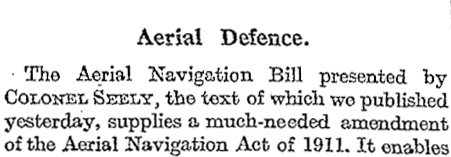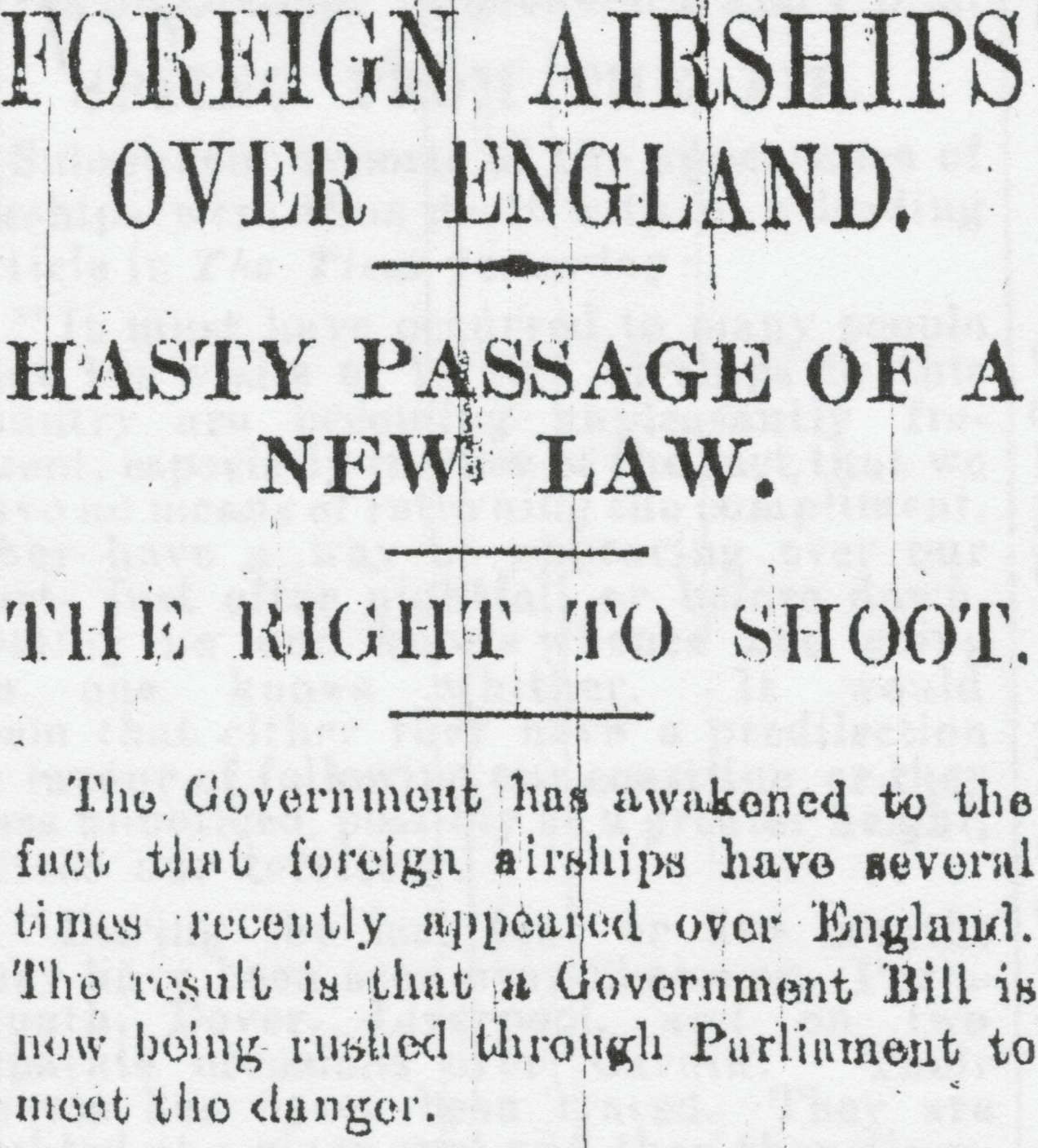
The Times hasn’t been ignoring the phantom airships, but neither has it focused its editorial attention on them — until now. The third leading article in today’s issue is in support of the government’s new Aerial Navigation Bill, arguing that ‘This strengthening of existing legislative powers can hardly be thought premature, and may indeed be regarded as somewhat belated’ (p. 7; above). The Times thinks the mystery airships are real, and it also thinks they are hostile.
It must have occurred to many people that the visits of foreign airships are becoming unpleasantly frequent, especially in view of the fact that we have no means of returning the compliment. They have a way of appearing over our ports just after nightfall or before dawn, coming no one knows whence and going no one knows whither. It would seem that either they have a predilection in favour of following our coastline, or they pass unnoticed, possibly at a greater height, across our territory. During the last four or five months they have been seen over Sheerness, Portsmouth, Dover, Liverpool, and on two separate occasions over Cardiff. Their course has never been traced. They are sighted at a given spot and then they disappear. That circumstance not only gives a surreptitious air to their visits, but raises an unpleasant suspicion that these visits may be more frequent than we know.
It then goes on to explain the threat posed by these mystery airships:
This aerial espionage of unknown extent and minuteness is an intrusion which we have a right to resent. Its motives are not likely to be friendly, nor can we flatter ourselves that the beauty of a bird’s-eye view of our ports is so great as to lead foreigners to spend so much money in order to derive æsthetic gratification from it. Airships are already capable of being used to do a great deal of mischief, and their powers in this respect will certainly be extended. Suppose, for the sake of argument, that the possibility of using such powers has entered into the calculations of some foreign country, it is obvious that this reconnoitring in time of peace might be found of great utility should an occasion arise.
The Times rejects the notion that there exists a freedom of the air as there does a freedom of the seas: ‘The analogy of the sea is no analogy at all. A ship on the high seas cannot drop explosives into our arsenals, but an aircraft can’. Moreover, even on the high seas every ship ‘has to display her name and to carry papers showing her movements, her registry, her nationality, and so forth. There is no analogy between ships and these aerial visitors to our ports’.
Our sovereignty goes up to the sky and down to the centre. In the past it has not been necessary to say so because no one had the means to challenge our dominion or to invade our atmosphere without first conquering our soil. The means of attacking us through and by the air now exist. It is therefore our business to define our rights and to make it plain that the air above us is our own, subject, like our soil and our territorial waters, to whatever municipal regulations we find it expedient to make.
And not only is legislation along the lines of the Aerial Navigation Bill necessary, but ‘we also need an aerial police to enforce our regulations, in addition to whatever means we already possess’.
Another newspaper also sees in the mystery airships the justification for the new legislation. The Irish Independent (Dublin) begins a leading article by suggesting (p. 4)
It seems as if there must have been some truth in the recent rumours that foreign airships were seen hovering at night over various British ports, and even so far inland as Manchester. The Bill which Col. Seely, the Secretary for War, has introduced is clearly designed to cope with inquisitive foreigners of this description.
After describing the ‘quite drastic’ powers granted by the bill, it concludes that
So sweeping a regulation would scarcely be proposed unless the Government was seriously disturbed by the risk which is run of having the secret defences of the United Kingdom discovered by foreign airmen.
Unlike The Times, however, the Independent does not say whether it supports the bill or not.
Finally, in non-airship mysterious lights news, the London Standard prints two letters continuing its previous correspondence on the subject. They are evidently in response to intervening letters (not seen) about British versions of the phenomenon, rather than Indian ones as before. The first is from Henry V. Heber Percy of Leasingham Rectory, Sleaford (p. 14):
There was a wonderful display last week in this parish of the curious phenomena known in Lincolnshire by the name of ‘Peggy Lanterns.’
One evening three were seen close together, each about the size of a good bicycle lamp — one very red, and the other two bright white lights. The red light travelled more slowly than the other two. Several people saw them. Other single ones have also been seen.
Can any of your readers kindly explain what particular moss or vegetation the gas that forms the light arises from, and, further, what the curious name ‘Peggy Lanterns’ is derived from?
The second is from E. A. Rawlence of Newlands, Salisbury:
I was recently informed by a very intelligent and observant Dorset farmer that he and his wife had seen very much the same phenomenon as described by Mr. Ramsbotham.
A phosphorescent light came up the valley leading to his farm, gyrated about over his barn, then turned and went away. My friend’s idea was that it was some nocturnal bird which had the ability to emit this phosphorescent light to attract the moths on which it fed, upon the same principle as the glow-worm or angler fish. Certainly the movements of the light as described by Mr. Ramsbotham and my friend exactly picture the flight of a nightjar or bat when hawking for its food.
It would seem to be impossible that a light gas such as that of which a will-o’-the-wisp consists or that emanating from an oil deposit could float backwards and forwards or up and down in the way described. It must be at the mercy of the wind. The only thing against my friend’s theory is that if it does emanate from some bird or bat it is surprising that it is not seen more frequently.
As ever, no comparison is made between these strange lights moving in the air and the other strange lights moving in the air which have been labelled airships.
![]() This work is licensed under a Creative Commons Attribution-NonCommercial-NoDerivatives 4.0 International License.
Permissions beyond the scope of this license may be available at http://airminded.org/copyright/.
This work is licensed under a Creative Commons Attribution-NonCommercial-NoDerivatives 4.0 International License.
Permissions beyond the scope of this license may be available at http://airminded.org/copyright/.




“Mr. Ramsbotham” was perhaps the same of this earlier account:
Ramsbotham, F[ielden James] (1891, October). The “Ignis Fatuus,” or, Will o’ the Wisp. Quarterly Journal of the Royal Meteorological Society 17(80), 260
Transcription available here:
http://inamidst.com/lights/wisp/ramsbotham1891
Yes, that seems very likely! However, I’ve looked in the online archive for the Standard back to 6 January and can’t see a letter from him. Perhaps it was earlier, or perhaps it was mentioned in a article or lecture report. Unfortunately the OCR is extremely poor (it doesn’t find ‘standard’ at all for the period 1 January-30 April 1913!) so I could only do a manual search.
Using my last days of subscription to NewspaperArchive.com, I found it!
Actually, the author of the letter was a brother of F. J. Ramsbotham, some R. H. (probably Richard Hugh):
Ramsbotham, R. H. (1913, January 31). [Moving lights]. The London Standard, 13
Thanks, and well done on finding it — it’s a bit of a worry that I wasn’t able to, but Newspaper Archive has such a terrible interface that I don’t feel too bad about it.